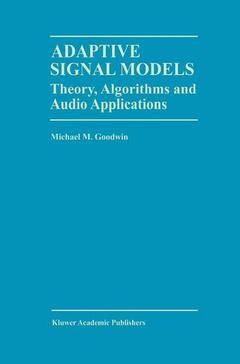Adaptive Signal Models, Softcover reprint of the original 1st ed. 1998 Theory, Algorithms, and Audio Applications The Springer International Series in Engineering and Computer Science Series, Vol. 467
Auteur : Goodwin Michael M.

The second chapter gives a detailed development of the sinusoidal model as a parametric extension of the short-time Fourier transform. This leads to multiresolution sinusoidal modeling techniques in Chapter Three, where wavelet-like approaches are merged with the sinusoidal model to yield improved models. In Chapter Four, the analysis-synthesis residual is considered; for realistic synthesis, the residual must be separately modeled after coherent components (such as sinusoids) are removed. The residual modeling approach is based on psychoacoustically motivated nonuniform filter banks. Chapter Five deals with pitch-synchronous versions of both the wavelet and the Fourier transform; these allow for compact models of pseudo-periodic signals. Chapter Six discusses recent algorithms for deriving signal representations based on time-frequency atoms; primarily, the matching pursuit algorithm is reviewed and extended.
The signal models discussed in the book are compact, adaptive, parametric, time-frequency representations that are useful for analysis, coding, modification, and synthesis of natural signals such as audio. The models are all interpreted as methods for decomposing a signal in terms of fundamental time-frequency atoms; these interpretations, as well as the adaptive and parametric natures of the models,serve to link the various methods dealt with in the text.
Adaptive Signal Models: Theory, Algorithms and Audio Applications serves as an excellent reference for researchers of signal processing and may be used as a text for advanced courses on the topic.
Date de parution : 09-2012
Ouvrage de 248 p.
15.5x23.5 cm
Thèmes d’Adaptive Signal Models :
Mots-clés :
Audio; Signal; algorithm; algorithms; coding; composing; development; filter; filters; model; modeling; psychoacoustics; signal processing; wavelet



